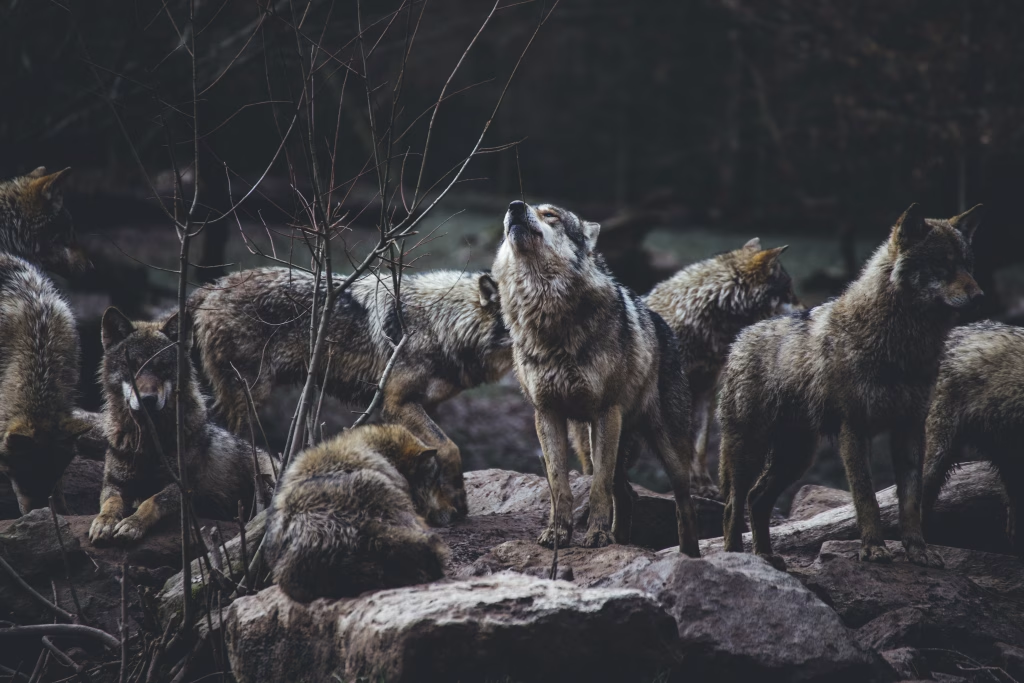It Starts With a Look
Your dog is watching you, ten minutes before you even touch the food bin. They shift their weight, ears perk up, tail swaying in anticipation. It’s more than hunger. It’s ceremony.
Many dog owners see mealtime as a task, but for your companion, it’s part of something deeper, shaped by thousands of years of wild memory. And to truly nourish our dogs, we must understand where their instincts come from.
The Wolf’s Way of Eating
Wolves, the ancestors of today’s domesticated dogs, live by nature’s clock. Meals depend entirely on a successful hunt. When prey is caught, the entire pack participates in a feast, sometimes consuming several pounds in one sitting. Then comes the wait.
No scheduled servings. No daily portions. Just instinct-driven consumption followed by rest and digestion.
In this case hierarchy defines the process: leaders eat first, followed by other members of the group. This ritual strengthens bonds, enforces order, and teaches young wolves about patience, respect, and survival.
Though dogs no longer roam the wilderness, the internal rhythm remains. When your pup circles the bowl or becomes possessive over food, they’re not misbehaving. They’re speaking the language of their lineage.

Why Modern Feeding Habits Fall Short
Today’s dogs often eat two or more times per day, sometimes from always-full bowls. While this satisfies basic needs, it erases the emotional and biological complexity behind nourishment. This constant availability leads to mindless snacking, disinterest, and weight gain. More importantly, it disconnects dogs from their natural cues and drive.
According to Tufts Veterinary Nutrition, structured eating not only supports physical health, but also regulates mood and behavior.
Many modern pet routines are focused on human convenience, not canine biology. We often feed by the clock, regardless of whether the dog is truly hungry or needs fuel. This disconnection may contribute to behavior problems such as restlessness, food guarding, or even digestive discomfort.
Recreating the Rhythm: Bringing Instinct into the Bowl
You don’t have to become a hunter to honor your dog’s heritage. But by adjusting how and when they eat, you can revive the mental engagement and biological balance they crave. Just Start by establishing consistent eating times. Avoid free-feeding. Present meals and remove leftovers after 15 to 20 minutes. This creates expectation, not anxiety. Then, add challenge. Dogs are wired to earn their nourishment. Scatter food in the backyard. Use puzzle feeders. Hide small portions around the house. These acts awaken problem-solving instincts and promote calm satisfaction.
Even slowing down fast eaters helps. Tools like snuffle mats or frozen food-stuffed toys transform a passive moment into meaningful activity.
Feeding routines can also include obedience elements. asking your dog to wait, sit, or perform a calm behavior before being allowed to eat. This reinforces trust and communication, reminding the dog that you provide security and leadership.
Fewer Meals, Greater Balance
Unlike grazing animals, canines in the wild often go long periods without eating. When food is available, they feast. When it isn’t, they conserve energy. Mimicking this, can benefit modern dogs. Many thrive on just one or two meals per day, especially when those meals are rich in nutrients and appropriately sized.
The Dog Aging Project reports that controlled meal schedules may improve longevity and reduce inflammation in healthy adult dogs.
For dogs with specific needs (puppies, seniors, or those with medical conditions), more frequent meals may be appropriate. But the principle remains: eat with purpose, not out of boredom.
Veterinarians often note improved digestion, increased interest in food, and better stool quality when dogs follow a more natural mealtime pattern. Behaviorally, they become calmer, less food-obsessed, and more focused during training.
Rethinking What They Eat
Wolves consume raw meat, organs, bones, and minimal plant material. While dogs have adapted to digesting more starches, their bodies still prefer protein-rich, species-appropriate foods. For your dog try to choose meals centered around real meat. Minimize fillers. Explore fresh or raw feeding if you’re able, and always consult a vet before making changes.
Even if you’re not ready to go raw, you can boost your dog’s nutrition with small, natural additions: bone broth, lightly steamed vegetables, or omega-3 oils. These enhance flavor and health benefits while honoring your dog’s biological heritage.
Always remember! You’re not trying to recreate the wilderness. You’re aiming to respect its blueprint.
Resources like the Raw Feeding Veterinary Society provide balanced guidance for pet parents considering ancestral diets.
Leadership Through Mealtime
In wolf packs, order around food maintains peace. It’s not about dominance, it’s about clarity.
In your dining room, simple rituals like asking your dog to sit before eating, or feeding after your own meal, can help establish boundaries. This isn’t punishment. It’s a way of reinforcing cooperation. And the result is: Your dog looks to you for structure, not control, but confident direction.
Feeding is not just provision, it’s partnership. When your dog sees that food comes through respectful behaviors, they relax. They understand their place, and you deepen the bond.
Feeding the Body, Awakening the Mind
True nourishment goes beyond calories. It’s about timing, effort, satisfaction, and trust. By tuning into the wild roots of your dog’s behavior, you offer more than a meal. You offer meaning.
In other words, you have to recreate the rhythm. Invite participation. Encourage anticipation. And in doing so, transform feeding into bonding.
This isn’t just a trend. It’s a return to balance.
Explore Wild Roots Of Dogs on Pawlore:



One thought on “Natural Feeding Routines for Dogs Based on Wolf Packs”